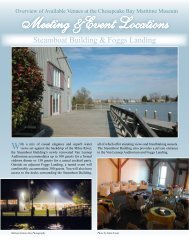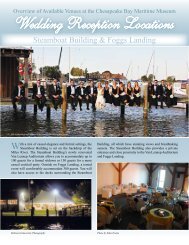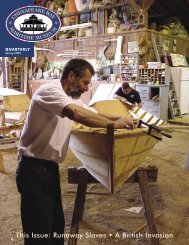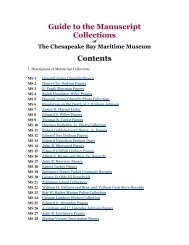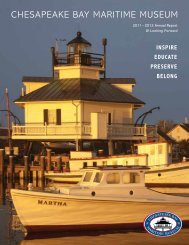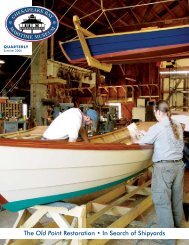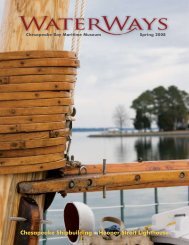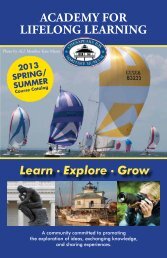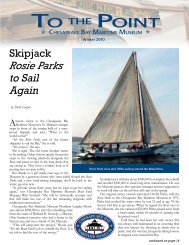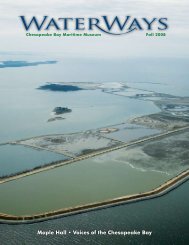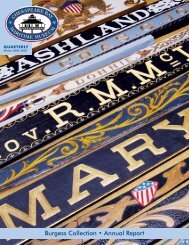Fall 2004 - Chesapeake Bay Maritime Museum
Fall 2004 - Chesapeake Bay Maritime Museum
Fall 2004 - Chesapeake Bay Maritime Museum
Create successful ePaper yourself
Turn your PDF publications into a flip-book with our unique Google optimized e-Paper software.
QUARTERLY<br />
<strong>Fall</strong> <strong>2004</strong><br />
Dude Schooner Promotions • Trade During the Quasi-War
President’s Message<br />
QUARTERLY<br />
<strong>Fall</strong> <strong>2004</strong><br />
Volume 2 Number 3<br />
Editor<br />
Michael Valliant<br />
Graphic Design<br />
Rob Brownlee-Tomasso<br />
Contributors<br />
Cathy Connelly,<br />
Kerry Wargo Clough,<br />
Pete Lesher, Melissa McLoud,<br />
John Miller, Rachel Rébert,<br />
Lindsley Rice,<br />
Leigh Ann Schaefer<br />
Photography<br />
Rob Brownlee-Tomasso,<br />
Rachel Rébert<br />
Illustrations<br />
Eric T. Applegarth<br />
<strong>Chesapeake</strong> <strong>Bay</strong> <strong>Maritime</strong> <strong>Museum</strong><br />
Navy Point, P.O. Box 636<br />
St. Michaels, MD 21663-0636<br />
410-745-2916 • Fax 410-745-6088<br />
www.cbmm.org • editor@cbmm.org<br />
The <strong>Chesapeake</strong> <strong>Bay</strong> <strong>Maritime</strong> <strong>Museum</strong> is a private<br />
not-for-profit 501(c)(3) educational institution. A<br />
copy of the current financial statement is available on<br />
request by writing the Controller, P.O. Box 636, St.<br />
Michaels, MD 21663 or by calling 410-745-2916 ext.<br />
238. Documents and information submitted under<br />
the Maryland Charitable Solicitations Act are also<br />
available, for the cost of postage and copies, from the<br />
Maryland Secretary of State, State House, Annapolis,<br />
MD 21401, 410-974-5534.<br />
On the Cover<br />
Blind Industries student Sarah Weinstein<br />
readies herself to rivet planks together<br />
in the CBMM Boat Yard, under the<br />
guidance of <strong>Museum</strong> shipwrights. Sarah<br />
and nine other students from Blind<br />
Industries and Services of Maryland,<br />
took part in the Lighthouse Overnight<br />
Program and Boat Yard as part of a fiveweek<br />
camp to build life skills. See page<br />
eight for a full story.<br />
The late Robert H. Burgess, undisputed<br />
“dean” of the <strong>Chesapeake</strong>, was known to<br />
hold up an artifact—say from a long-lost <strong>Bay</strong><br />
schooner—and ask, “Can you imagine what<br />
this saw in its day?”<br />
Burgess already knew the answer. His<br />
life’s work of collecting artifacts of the <strong>Bay</strong>’s<br />
vanishing maritime culture was based on very<br />
real experiences of working the water on sailing vessels that are now gone.<br />
Commercial sailing vessels of the late nineteenth and early twentieth centuries—<br />
schooners, sloops, skipjacks, pungys, bugeyes—were more than artifacts to<br />
him: they were a part of his way of life. He knew their names; he sailed on many<br />
of them. He knew where they were born, where they grew up, where they last<br />
sailed, who sailed them, and where they vanished—either broken up for scrap,<br />
left to rot in a shallow salt marsh, or lost in a storm at sea.<br />
“Can you imagine what this saw in its day?” What a wonderfully telling<br />
statement from the <strong>Bay</strong>’s most renowned curator. Such a question releases the<br />
imagination, gives license for it to wander. . . and to wonder.<br />
Artifacts at the <strong>Chesapeake</strong> <strong>Bay</strong> <strong>Maritime</strong> <strong>Museum</strong> do the same thing. Our<br />
permanent exhibits of <strong>Bay</strong> artifacts form the core educational experiences of<br />
our visitors. People come here to learn the stories of this place and its people<br />
through the objects and artifacts that we collect, organize, and interpret. As<br />
Bob Burgess knew so well, the best exhibits entertain and educate visitors in<br />
a way that books, lectures, or classes cannot.<br />
Educating through exhibits is our primary way to reach our audience. It’s<br />
something we do every day of the year, unlike a one-time class or special<br />
event. Our exhibits reach the most people, are the most visible part of our<br />
program, and they create a public product that brings together our research,<br />
oral histories, collections, and scholarship in new and interesting ways.<br />
The <strong>Museum</strong> demonstrates a history of innovation when creating new<br />
exhibits for our visitors—from moving the now 125-year-old Hooper Strait<br />
Lighthouse to Navy Point, to building our Oystering on the <strong>Chesapeake</strong><br />
exhibit around the skipjack E.C. Collier. Developing and presenting these<br />
exhibits to the public are, in short, the reason we exist as a museum.<br />
As we move forward with the construction of our upcoming At Play on the<br />
<strong>Bay</strong> exhibit, our staff is working on all fronts. From construction, to exhibit<br />
design and fabrication, to collecting the final artifacts and vessels, to marketing<br />
and creating communications and publications—it takes a comprehensive<br />
effort to create a new exhibit that allows our artifacts to “speak” their stories.<br />
When we open At Play on the <strong>Bay</strong> in 2005, you will see the newest<br />
example of our focus on improving the quality of our visitor experience<br />
through the highest quality exhibits about the <strong>Chesapeake</strong> <strong>Bay</strong>’s history and<br />
culture. Many of the artifacts in At Play on the <strong>Bay</strong> come from the 40s, 50s,<br />
and 60s—not that long ago. Can you imagine what they saw in their days?<br />
John R. Valliant<br />
President<br />
jvalliant@cbmm.org<br />
<strong>Chesapeake</strong> <strong>Bay</strong> <strong>Maritime</strong> <strong>Museum</strong> • <strong>Fall</strong> <strong>2004</strong>
Contents<br />
Moving Day—The Owens cruiser<br />
Nomad is transported to its new<br />
home in the At Play on the <strong>Bay</strong><br />
exhibit building on Navy Point.<br />
Departments<br />
To the Point<br />
Profile<br />
Events Calendar *<br />
From the Chairman<br />
8<br />
11<br />
C 1-4<br />
22<br />
* Events Calendar is a special pull-out<br />
section that can be found between<br />
pages 11 and 12.<br />
Features<br />
Folk Art Gone Afowl<br />
When is a decoy more than a duck? When it is carved from a skipjack<br />
mast, made from the newell post of a vanished hotel, or if the carver lies<br />
inside it. By Pete Lesher.<br />
Racing Workboats<br />
CBMM Quarterly continues its exploration of the <strong>Bay</strong>’s changing<br />
culture from work to play. Curator Pete Lesher looks at racing oyster<br />
dredgeboats and <strong>Chesapeake</strong> Appreciation Day.<br />
Carefree Days Under Sail<br />
12<br />
CBMM intern Jonathan Olly examines the post World War II promotion<br />
of <strong>Bay</strong> schooners from working boats to dude cruisers and how these<br />
tourist vessels were marketed and promoted.<br />
3<br />
5<br />
Peril on the Sea<br />
17<br />
Intern Cynthia Nuara traces the journey of Baltimore schooners Hunter<br />
and Fly to the West Indies at the turn of the nineteenth century. This<br />
Quasi-War story and the spoliation claims that followed are told through<br />
correspondence in the CBMM collection.<br />
Contents<br />
2
Folk Art Gone Afowl<br />
By Pete Lesher, Curator<br />
Decoys are representations of something they aren’t—a<br />
duck or shorebird, perhaps. But a number of recently carved<br />
duck decoys represent something more significant than the<br />
bird or waterfowl hunting culture on the <strong>Chesapeake</strong>. Instead,<br />
they commemorate a person, a place, or a historic boat that<br />
is meaningful to the carver or others. Duck decoys have not<br />
been officially adopted as a state symbol, like the rockfish, the<br />
<strong>Chesapeake</strong> <strong>Bay</strong> retriever, and the skipjack, although decoys<br />
are as just as evocative of Maryland and the <strong>Chesapeake</strong> in<br />
the popular imagination. Wooden decoys long ago underwent<br />
a change from tools of the hunter to decorative pieces. But a<br />
generation ago, who could have imagined a decoy fashioned<br />
from a piece of a skipjack, or a decoy used as a funerary urn?<br />
Choosing a piece of wood from an historic object and<br />
carving it into a decoy (or anything else) both commemorates<br />
the historic object and gives the finished piece a significance<br />
beyond the representation of a bird. It is not unlike the venerable<br />
Wye Oak, which, after falling in a windstorm two years ago,<br />
had its salvaged branches made into a desk for the governor of<br />
Maryland. The Wye Oak had been the largest living example<br />
of a white oak—another<br />
official state symbol—<br />
and in its afterlife as<br />
a piece of furniture,<br />
it continues in its<br />
symbolic role. Likewise,<br />
a decoy fashioned from the<br />
old mast of the 1886 oyster<br />
dredger Rebecca T. Ruark, now in<br />
the collections of the <strong>Chesapeake</strong> <strong>Bay</strong><br />
<strong>Maritime</strong> <strong>Museum</strong>, symbolizes much more<br />
than the waterfowling traditions of the upper<br />
<strong>Chesapeake</strong> <strong>Bay</strong>. The <strong>Museum</strong> similarly has a pair of<br />
canvasback decoys fashioned from the old bowsprit of the<br />
1901 skipjack Kathryn and a mallard drake cut from the old<br />
mast of the 1956 skipjack Lady Katie. These skipjacks, although<br />
still surviving, are honored in these decoys.<br />
This idea is not entirely new. J. Newnam Valliant (1900-<br />
1974) of Bellevue, Maryland, carved commemorative decoys<br />
including one in the <strong>Museum</strong>’s collections fashioned from the<br />
walnut newel post of the long-gone Sharp’s Island<br />
Hotel. Valliant held an affection for this place, as the<br />
rapidly-eroding island was once his family’s property<br />
and home. Walnut is a particularly hard and dense<br />
wood, thoroughly unsuited for a decoy intended to<br />
float in front of a duck blind, but this was considered<br />
too precious to use for hunting. Likewise, the wood for<br />
skipjack masts, though not as dense as walnut, would<br />
be unsuited for a working decoy, but that is not the<br />
point. Charles Jobes of Havre de Grace, Maryland, who<br />
Joey Jobes carved this pair of canvasback decoys from the old<br />
bowsprit of the skipjack Kathryn and a mallard (center) from the<br />
Lady Katie’s old mast. Gifts of H. Russell Dize and Scott Todd.<br />
3
Charles Jobes carved this commemorative<br />
decoy from the dredge boat Rebecca T.<br />
Ruark’s old mast. Gift of Wade H.<br />
Murphy, Jr.<br />
turned Rebecca T.<br />
Ruark’s old mast into eightytwo<br />
decoys, reported that he burned the carbide tips off the<br />
blade of his duplicating lathe while making the set. With the<br />
softer woods he ordinarily uses, a blade will typically cut about<br />
2,000 decoys for him.<br />
Jobes’s younger brother, Joey, made the decoys from Kathryn’s<br />
bowsprit and Lady Katie’s mast. Joey Jobes actually pioneered<br />
this work in making old pieces of skipjacks into decoys, and he<br />
did the same for the skipjacks Hilda M. Willing and Nellie L.<br />
Byrd. The younger Jobes related that one customer did not seem<br />
to understand the added significance of a decoy made from a<br />
piece of a historic boat, telling him that she was not going to pay<br />
a premium when she could get one of his regular decoys for $65.<br />
For others, however, it is worth more than the purchase price; it is<br />
a way to remember a favorite skipjack.<br />
A newer application of this regional symbol<br />
is the commemoration of a duck hunter’s life by<br />
inurnment in a hollow decoy. Imagine the surprise<br />
of the couple who found a decoy floating on Harris<br />
Creek when they picked it up and turned it over<br />
to read the carved inscription, “In this decoy lies<br />
the carver H. J. Waite 1939-2000.” Harry Waite,<br />
who loved hunting on the waters of the upper<br />
<strong>Chesapeake</strong> <strong>Bay</strong>, also carved decoys. He made the<br />
hollow canvasback decoy for his cremated remains in<br />
the 1970s and carved the inscription, except, of course, for<br />
the final date, which was added by his son. The decoy is made<br />
from sugar pine and was scorched with a torch to raise the grain,<br />
giving it a textured look. The decoy was cast adrift by family and<br />
friends gathered on the deck of Capt. Wade Murphy’s Rebecca<br />
T. Ruark in September 2000. It was found adrift after a day or<br />
two, and when the finders contacted Waite’s widow, they learned<br />
that one of his wishes was that the decoy be taken hunting. They<br />
arranged for this before donating the object to the <strong>Museum</strong>, and<br />
we accepted it with Mrs. Waite’s consent.<br />
Harry Waite’s decoy memorializes the decoy hunter in a<br />
very personal way—both as a product of his workmanship and a<br />
container for his remains. Similarly, the Jobes and Valliant decoys<br />
are not merely decorative; they take on commemorative meanings<br />
because they were carved from special pieces of wood.<br />
(Left) A generation ago, J. Newnam Valliant had the idea of<br />
turning a salvaged piece of wood into a commemorative decoy<br />
when he carved this duck from a piece of the Sharp’s Island<br />
Hotel. Gift of Mrs. J. Newnam Valliant.<br />
(Right) This hollow canvasback decoy was carved by duck<br />
hunter Harry Waite to carry his cremated remains. Gift of<br />
William and Mary Kepner.



